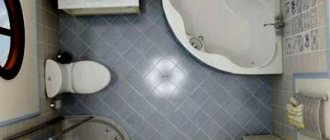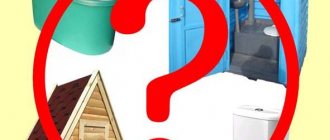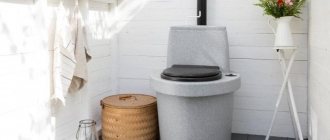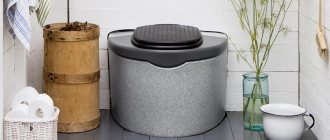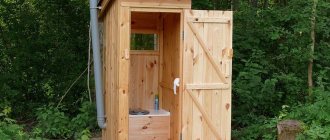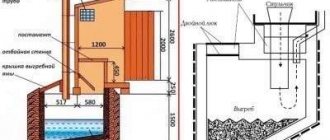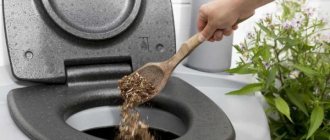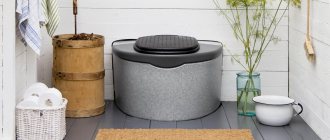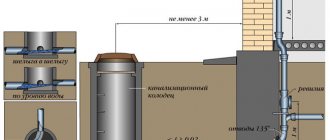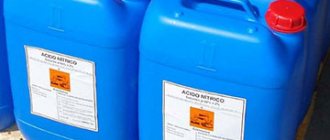Choosing a toilet location in a private house
The ideal place for arranging a future toilet is considered to be a ready-made room similar to a small storage room. It is advisable that it be located closer to the drain well.
When the location of the toilet is on the other side, the amount of work required increases, and accordingly the costs. As an option, you can consider arranging a combined bathroom in a small room, installing plumbing fixtures in it that will fit: a bathtub, a toilet, a washbasin, a shower stall, etc.
Things are much more complicated when there is no suitable premises. Then to install the toilet you should find a free corner. There is nothing wrong with the fact that such a place can only be in the kitchen. In this case, a homemade toilet is fenced off with a solid partition, and the entrance is made by cutting through it from the adjacent room, so unpleasant odors will not interfere. In this case, you can use materials such as chipboard, lining, drywall, etc. Read also: “Water supply and sewerage in a private house - design and installation.” Soundproofing material is placed between the layers of cladding, and then the use of the bathroom will not disturb the residents. The partition should be built after the installation of utilities has been completed, since plumbing work is difficult to carry out in a confined space.
Toilet in the country without smell
An unpleasant odor from a country toilet with a cesspool can spread for three reasons:
- leaky storage tank;
- the smell of drainage from the hole of the toilet seat;
- poor cabin ventilation.
Sources of odor in the toilet itself are blocked using standard water closet methods: flushing and a toilet water seal. Of course, the storage tank will fill up faster, but this is a price to pay for comfort.
Bucket toilet INGREEN ING30001FБЗ, INGREEN
Bucket toilet INGREEN ING30001FБЗ, INGREEN
top-shop.ru
1,250 rub.
Buy
Bucket toilet INGREEN ING30001МР-7РS, INGREEN
Bucket toilet INGREEN ING30001МР-7РS, INGREEN
top-shop.ru
1,250 rub.
Buy
Thermal seat with lid for country toilets “Country Warmth”. Assorted colors
Thermal seat with lid for country toilets “Country Warmth”. Assorted colors
top-shop.ru
RUB 1,599
Buy
Different designs and materials can be used as a storage tank:
- Brick pit. Dignity - any shape and volume. The disadvantage is the high cost and labor intensity, hygroscopicity of the material. Double waterproofing of the bottom and walls is necessary, otherwise drains will seep out or groundwater inside.
- Metal container. Two options: make it yourself, buy used.
- Plastic container. There are ready-to-install storage tanks for septic tanks and cesspools on sale. The conversion of “Eurocubes” for collecting wastewater is also popular.
- Concrete well. There are two manufacturing methods: pouring a monolithic reinforced concrete structure, assembling from standard well rings. The second design option is simpler and faster to manufacture.
The tightness of the pit is necessary not only so that it does not smell. Discharge of sewage into the ground is equated to deliberate damage to the land, which is subject to the Code of Administrative Offenses of the Russian Federation, the Land Code and the Law “On Environmental Protection”.
Sewerage installation in a private house
Depending on the type of transportation of sewage and waste, sewerage can be:
- pressure (forced);
- non-pressure (gravity flow).
The pressure structure uses a fecal pump to move waste. As for gravity drainage, it occurs due to the slope of the pipes (more details: “The slope of the sewer in a private house - what it should be”). If you have not yet decided how to make a toilet in a private house, you can use any option depending on the circumstances.
Gravity sewer system
The effective operation of such a structure can be ensured if the slope parameters are strictly observed - it must be constant and uniform throughout the entire length of the pipe. Most often, when installing a bathroom in a private house with your own hands, they allow you to create a slope that is too steep. The fact is that the very fast movement of drains does not allow them to fill the pipe completely and for this reason the inner surface is poorly washed.
In the case when the slope is less than permissible, the speed of the flow slows down and this point is a big drawback (read: “What is the optimal slope of a sewer pipe”). It is necessary to ensure such a ratio between the filling of the pipe and the speed of sewage movement so that self-cleaning occurs during its operation. Otherwise, a coating will appear on the inner surface of the pipeline, preventing drainage and contributing to the formation of blockages. The optimal slope of sewer pipes is prescribed in SNiP. For pipes with a diameter of 40-50 millimeters - this is 3%, with a diameter of 80-110 millimeters - 2%.
Sewage type
There are two main varieties:
- toilet without sewerage. There are several types that can be arranged in different ways. All of them are united by one feature - there is no pipeline system through which wastewater and organic waste move;
- autonomous sewer system. Various options can also be used here - from a regular cesspool to a septic tank or biological wastewater treatment station.
1) Without sewerage - wastewater goes into a septic tank 2) Autonomous sewerage
You may also like: Sewerage in the country - choice and design
Both options have their pros and cons. A toilet in a wooden house without a sewer system does not require a large amount of excavation work (or does not need it at all) and can be installed in any room. At the same time, it is not capable of fully performing the functions of a bathroom. The volume of wastewater that it can accommodate without treatment is small and requires constant limitation of the amount of discharge.
An autonomous sewer system based on a septic tank or treatment plant is more difficult to install and requires a large volume of excavation work and compliance with all technological requirements. However, the operation of such a system ensures full functionality, allows you to use the bathroom all year round and is no different from the city sewer system in an apartment.
For more details, see the article: Autonomous sewage system for a private house - how does it work and how to choose?
A simpler option is a cesspool, but it requires frequent cleaning and spreads a disgusting smell throughout the area. The only difference between a cesspool and a regular village outhouse is that there is a toilet installed in a warm place.
Both types of sewerage can be organized with a waste disposal method. There are systems that operate on the principle of natural outflow of water, but there are other complexes with forced movement of wastewater; let’s consider them separately:
Gravity system
A sewer system based on the natural movement of wastewater through pipes located with an appropriate slope. It is good because it can work all year round and does not require an electrical connection. The gravity system consists of two adjacent sections:
- internal sewerage. It consists of a vertical riser, from which there are branches to all plumbing fixtures and devices. The upper part of the riser is continued in the form of a pipeline that goes out onto the roof and ends slightly above the level of the ridge. This is a drain pipe; it is necessary to remove sewer gases. At the bottom of the riser there is an outlet that passes through the wall or base and connects to the outside of the system;
- external sewerage. This is the entire external (underground) part of the system - a septic tank, a filtration well (or filtration field), supply pipes.
It is noteworthy that the internal part of the system, although in a somewhat simplified form, is also necessary when a toilet is used for a home without a sewer system. If a composting toilet is not used, then a closed plastic container is immersed in the ground, into which wastewater and waste are dumped. This type of construction is not far from a cesspool, requires frequent pumping of waste and requires control over the volume of waste. But it is simpler and more economical, and is often used in dachas, where people do not live permanently and practically never visit in winter.
A toilet in a country house without a sewer system is also convenient because it does not take up space for a filtration well from the area of the site and does not require trenches. This allows you to preserve the plantings and not lose the harvest.
A simple option for seasonal living
Pressure sewer
A pressure sewer system is a set of equipment that provides mechanical pumping of wastewater into the receiving chamber of a septic tank or other reservoir.
It requires the use of a fecal (mud) pump and a connection to the power supply, without which the system will not be able to operate. At the same time, the creation of such a system does not require ensuring a technological slope of the pipelines and allows you to equip the toilet at a level lower than the receiving tank. This is convenient if the site has complex terrain or is located on a slope or fold of terrain.
Pressure systems require pipes of smaller diameter, which simplifies installation and does not require serious damage when laying the inside of the sewer. There are different designs of pressure systems; there are even toilets with a built-in pump. They are expensive and require periodic maintenance, but are more resistant to external influences and are able to provide stable operation.
Pressure system
In some cases, installing a toilet with gravity sewerage is problematic.
Laying pipes with a diameter of about 100 millimeters through partitions and walls is quite difficult. Problems can be avoided if you install a pressure sewer system, the main element of which is a fecal pump (read: “Pressure sewer system - what is it, examples of devices”). The use of this device leads to the fact that waste waste can move from bottom to top, despite the fact that the cross-section of the pipes is reduced significantly.
Fecal pumps designed for domestic needs are distinguished by their compact size, aesthetic appearance, and the ability to pump liquid several meters in the vertical direction and tens of meters horizontally. Toilets with a built-in pump are available for sale.
Features of waterproofing
To ensure that the finishing of the room lasts a long time, and that the wood does not quickly rot over the years of use of the bathroom, it is necessary to consider waterproofing the structures.
Types of materials
The choice of waterproofing material depends on the type of decoration of the room. In hardware stores you can find the following waterproofing compounds:
- Coatings. With their help, it will be possible to obtain a water-resistant coating. The material consists of mastic and emulsions, which are applied using a brush or roller. Number of layers – 3.
- Stickable. Available in rolls and sheets. They need to be glued overlapping. The seams between individual elements are subject to additional sealant treatment.
- Impregnating. Good waterproofing materials, the only drawback is the presence of chemical additives in the composition. Therefore, it is not recommended to use them when arranging a bathroom.
The uniqueness of the water-repellent material is achieved with the help of additives that are harmless to the human body. For example, to glue sheet or roll compounds, mastic-based adhesives are used.
Stages of waterproofing
Protecting bathroom surfaces from moisture is carried out in several stages:
- First, everything is cleaned of dust and dirt.
- A primer is applied to the walls and ceiling, and the floor is additionally treated with bitumen-based mastics.
- Apply a waterproofing compound or glue a water-repellent material.
Special attention should be paid to the floor. After its surface has been treated, you should begin installing a special waterproofing film, on top of which you will need to apply a cement-sand screed. The screed is additionally reinforced with mesh or plasticizer.
Waterproofing walls is carried out in various ways:
- treat the surface with latex-based waterproofing
- coat the surface with mastic and lay the tiles
- impregnate the wood with oil compounds if additional finishing is not planned
Bitumen mastic is applied to the ceilings using 2-3 layers, additionally covering the surface with an antiseptic composition.
Construction device
For laying sewerage in a house, polypropylene pipes are a good choice, which are durable, lightweight and able to withstand temperatures up to 95 degrees without deformation. The last advantage will come in handy when a washing machine is connected to this area or someone pours boiling water into the toilet.
Plastic sewerage is easy to assemble, as if it were a children's construction set.
Installation begins from the lowest point, for which the next element is inserted into the socket of the previous part, but before that, sealant for plastic pipes, which is intended for such work, is applied to the end of the fitting or pipe. This is necessary both to prevent leaks and to facilitate installation work. The fact is that with such a diameter of pipes, joining is not easy - it requires considerable effort. When the ends of the element are lubricated, the work happens much faster. When installing sewerage, you should avoid using right-angle bends, and a 90° turn can be performed using two 45° bends and thereby reduce the inhibition of fluid flows.
If you need to shorten a long section of pipe, use a hacksaw. To secure the structure, use clamps on studs or clips (the latter products look more presentable).
Before each turn, at the bottom of the risers and at the point where the sewer exits outside the house, inspections should be installed.
If there is a need to combine a new plastic pipe with an old cast iron product, the connection is sealed using a special rubber cuff. If there is a basement or room under the toilet for which the interior is important, then a horizontal section of the pipe can be placed in them under the surface of the ceiling. This solution has obvious advantages:
- there is no need to go around corners, since the pipes will be laid along the shortest route, and this will save materials and time, and therefore money;
- sewer pipes will not take up space at the bottom of the room.
The elements that make up the pressure sewer are connected together by welding or using flanges. Depending on the characteristics of the fecal pump, the diameter of the pipes can vary between 20-40 millimeters. Laying can be done both from the outside and under the floor or in a wall groove.
How to arrange a cesspool
Installing a toilet in a country house according to all the rules is largely limited by the need to comply with the requirements when creating a cesspool. SanPin provides two designs for the drain tank. The possibility of their use is determined by the daily amount of waste.
The first is open type. It is built without a bottom, so some of the waste flows into groundwater. The result: a negative impact on the quality of water in nearby reservoirs. Soil fertility indicators are also partially deteriorating.
The second option is the closed type. It is safe to use, as it ensures the tightness of the drainage tank, but they require large investments and are more difficult to design. It is advisable to install in small areas.
In accordance with SanPin standards, the construction of an open-type cesspool is possible if the total volume of waste does not exceed 1 cubic meter per day. Otherwise, the equipment of the second option is required.
Special attention should be paid to the design of the lower part of the pit. When arranging the filter bottom, it is necessary to provide for the formation of:
- sand cushion;
- crushed stone pillow;
- stone layer using materials of different fractions.
If more than 4 adults live on a summer cottage, you will need to construct a multi-chamber pit or septic tank. This ensures greater protection of the environment from waste toxins.
The legislation provides for a significant fine for a septic tank without a bottom, up to and including a court decision to liquidate the tank from the site, so it is important to comply with all the requirements of regulatory documents.
How to make a sewer outside
The design of the toilet involves laying the outer part of the sewer in a trench, the depth of which depends on the climate in the region.
In this case, different pipes are used - from asbestos, cement, cast iron, plastic and ceramics. The most popular are plastic products. For installation in trenches, only special plastic pipes are used; they are usually painted orange. In places where there is an increased load on the soil or sewerage is laid at great depths, preference should be given to products made from more durable materials or corrugated pipes (pro
Required tools and materials
For the sewer option, gray pipes for internal work with a cross-section of 50 mm, orange for external work with a cross-section of 110 mm and connecting fittings are required.
To build outdoor amenities you will need:
- beams for the frame base;
- sheet plywood;
- batten;
- roofing;
- door block.
If you don’t want to build a seat manually, you can install a plastic toilet without a tank.
Tools that may be useful are a level and a tape measure, a screwdriver or drill, a jigsaw or a hacksaw, a tape measure, a hammer and a shovel.
Toilet installation
- Usually, in our own homes, the floors are made of wood, so before making a toilet in a private house, they should be leveled, strengthened and laid with linoleum. If the neck of the pipe is located above the toilet outlet, it needs to be raised. The podium can be made from a wide board or pieces of timber. If the installation is planned on a concrete floor (for example, on the basement), then brick and cement will be required.
- Most often, the connection to the sewer can be made directly: a cuff with an O-ring is inserted into the pipe, and the toilet outlet is inserted into it. In cases where this is not possible, use a plastic eccentric or corrugated cuff.
- Connecting to a fecal pump will not cause difficulties, since the inlet on it is located at a standard height, and everything that is necessary for docking is available.
- After the toilet is installed in the place intended for it, and after making sure that it is securely connected to the sewer pipe, the holes are marked.
Then the plumbing is moved aside and the floor is drilled. A set of fasteners is usually included with the toilet. It consists of self-tapping screws, plastic dowels, washers and decorative caps. The toilet is returned to the place prepared for it and checked how level it is using a building level. If necessary, level the base by placing a solid object. After completion of the work, the resulting gap is filled with cement. - The plumbing fixture is secured with self-tapping screws, placing soft washers under the caps.
The junction with the pipe and cuff should be syringed using silicone sealant.
Do the same with the base of the toilet so that water does not flow under its bottom. Now all that remains is to connect the water to the drain tank. As a rule, a coaxial hose is used for connection, placing a tap in front of it. As a result, a well-appointed bathroom will certainly improve the quality of life of the household.
Features of connection to water supply and sewerage
install the connection to the water supply and sewerage
yourself To connect to the pipe there is a flexible hose with nuts at both ends. Sealing on the side of the plumbing equipment occurs using rubber gaskets or a special tape.
You can simultaneously place a tap on the pipe so that you can shut off the water flowing into the tank. In this case, other water intake points will work.
How to install a toilet correctly if the drain is different from the previous equipment? The pipes will have to be re-routed to match the new model.
Installing a toilet with an oblique outlet
Floor models come with an oblique, vertical or horizontal drain. Installing a toilet with an oblique outlet differs from the vertical or horizontal method.
To prevent the joint from leaking , you need to:
- lubricate the outlet pipe with red lead - oil paint mixed with drying oil;
- wind the fiber and then also apply paint;
- fix the pipe in the sewer pipe.
Installation of a toilet with an oblique outlet is carried out if the previous equipment had the same drain.
Installation of toilets with an attached cistern
The monoblock lasts a long time, so when purchasing a model, it is recommended to immediately purchase spare internal parts, since models on the market often change, and after a while they will no longer be produced.
Installation of toilets with a directly connected is carried out as follows:
- the pipe connects to the sewer;
- the toilet seat is fixed in the floor;
- water is connected.
It is recommended to purchase a similar type of sink so that the difference in styles is not obvious.
